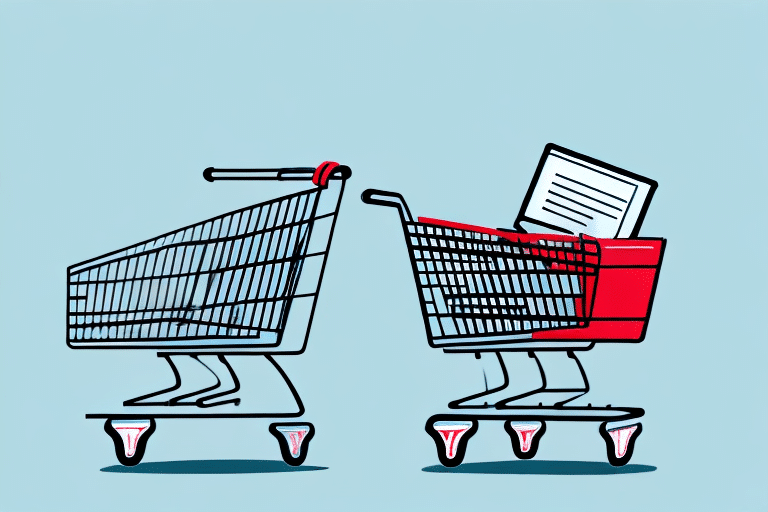Comparing Abandoned Cart vs Abandoned Checkout: What You Need to Know
In the world of e-commerce, cart abandonment and checkout abandonment are two terms that are commonly used by online businesses. While both these terms refer to customers leaving the purchase process incomplete, they are different from each other. In this article, we will explore the differences between abandoned cart and abandoned checkout, their reasons and impacts, ways to measure and reduce abandonment rates, and the future of e-commerce in relation to addressing this challenge.
Understanding Cart and Checkout Abandonment
Difference between Abandoned Cart and Abandoned Checkout
Abandoned cart refers to the act of customers adding items to their cart but leaving the website before completing the purchase. On the other hand, abandoned checkout refers to customers leaving the website during the checkout process after adding their personal and payment information. Essentially, cart abandonment occurs before the checkout process, and checkout abandonment occurs during the checkout process.
It is important for businesses to track both cart and checkout abandonment rates to identify potential issues in the purchasing process. For example, a high cart abandonment rate may indicate that customers are having difficulty finding the checkout button or that shipping costs are too high. A high checkout abandonment rate may indicate that the checkout process is too complicated or that there are technical issues with the payment system. By identifying and addressing these issues, businesses can improve their conversion rates and increase sales.
Common Reasons for Abandonment
- High shipping costs
- Unexpected fees
- Lack of trust in the website
- Complex checkout process
- Slow website browsing speed
- Technical issues on the website
- Limited payment options
- Insufficient product information
Additionally, customers may abandon their carts if they are just browsing items and are not ready to purchase yet or if they have found the same item cheaper elsewhere.
Impact of Abandonment on Your Business
Cart abandonment and checkout abandonment can have a significant impact on your business. When customers abandon their carts or checkouts, you lose out on potential sales and revenue. Moreover, if this problem is widespread, it could lead to a decline in your conversion rates, which is a critical metric for measuring the success of your online business.
To combat this issue, it's important to offer transparent pricing and shipping information, simplify the checkout process, and provide reassurance to customers about the security of their personal and financial information.
Measuring Abandonment Rates
Measuring your cart abandonment and checkout abandonment rates can help you determine the extent of the problem and identify ways to reduce it. To measure these rates, divide the number of abandoned carts or checkouts by the total number of carts or checkouts initiated and multiply by 100 to get a percentage. According to Statista, the average cart abandonment rate in e-commerce is around 70% as of 2023.
You can use tools like Google Analytics or various e-commerce platforms to track this metric.
It's important to note that cart abandonment and checkout abandonment rates can vary depending on the industry and type of product being sold. For example, high-end electronics may have a higher abandonment rate than everyday necessities due to the higher price point. Understanding these nuances can help you set realistic goals for reducing abandonment rates.
In addition to tracking abandonment rates, it's also important to analyze the reasons why customers are abandoning their carts or checkouts. Common reasons include unexpected shipping costs, a complicated checkout process, or concerns about payment security. By addressing these issues, you can improve the overall customer experience and reduce abandonment rates.
Strategies to Reduce Abandonment
Tips for Reduction
- Make Your Website Mobile-Friendly: With the increasing use of mobile devices for shopping, ensuring your website is optimized for mobile can reduce abandonment rates.
- Provide Multiple Payment Options: Offering various payment methods like credit cards, PayPal, Apple Pay, and other digital wallets can cater to different customer preferences.
- Display Shipping Costs Upfront: Transparency in shipping fees helps prevent unexpected costs that can lead to abandonment.
- Simplify Your Checkout Process: Reducing the number of steps required to complete a purchase can decrease the chance of customers dropping off.
- Ensure Fast and Responsive Website: A slow website can frustrate customers and lead to abandonment.
- Offer Incentives: Discounts, free shipping for first-time customers, or loyalty rewards can encourage customers to complete their purchases.
- Clear and Visible Return Policy: Providing a straightforward return policy can alleviate customer concerns and reduce hesitations.
Best Practices for Recovery
- Send Abandoned Cart Emails: Personalized emails reminding customers of the items left in their cart can prompt them to complete their purchase.
- Offer Discounts or Coupons: Providing a limited-time discount can incentivize customers to return and finalize their purchase.
- Implement Retargeting Campaigns: Using ads to target customers who left their carts can bring them back to complete their purchase.
- Provide Excellent Customer Service: Prompt and helpful support can assist customers in overcoming any obstacles they faced during the checkout process.
Case Studies: Successful Examples
Several businesses have successfully reduced their cart abandonment and checkout abandonment rates. For example, an online retailer reduced their checkout abandonment rate by 20% by optimizing their checkout process and providing various payment options. Another business decreased their cart abandonment rate by 15% by offering additional incentives when customers completed their purchases. These case studies provide valuable insights into successful strategies that businesses can adapt.
Additionally, offering free shipping has been highly effective. A study by the Baymard Institute found that 44% of customers abandon their carts due to high shipping costs. By offering free shipping, businesses can incentivize customers to complete their purchases and reduce abandonment rates. Providing clear and transparent information about shipping costs and delivery times also helps build trust with customers.
Enhancing Customer Experience to Prevent Abandonment
Role of Customer Experience
Your customers' experiences on your website play a crucial role in reducing cart and checkout abandonment rates. Providing an excellent customer experience involves making sure that your website is user-friendly and easy to navigate, and that you provide quick and responsive customer support. Ensuring that your customers feel safe and secure while making their purchases also goes a long way in reducing these abandonment rates.
Timely Communication with Customers
Communicating with your customers after cart or checkout abandonment is crucial for businesses that want to recover lost sales. Sending timely and personalized abandoned cart or checkout emails that offer incentives can persuade customers to return and complete their purchase. These emails demonstrate that you care about your customers' needs and that their shopping experience is essential to you.
Overcoming Common Challenges
Reducing cart and checkout abandonment rates can be challenging, and businesses need to be prepared to overcome common obstacles. These challenges include identifying the reasons for abandonment, providing suitable solutions, and ensuring that your tools and strategies align with your customers' needs. Moreover, you must be willing to test and iterate these solutions continually to find what works best for your specific audience.
Future Trends in E-commerce Addressing Abandonment
The e-commerce industry is continually evolving, and businesses must stay on top of emerging trends to address cart and checkout abandonment rates. One trend gaining traction is using artificial intelligence to optimize checkout processes and personalize communication with customers. Other trends include using social media for retargeting and implementing frictionless payment options like one-click checkouts. Additionally, integrating augmented reality (AR) can enhance product visualization, thereby reducing uncertainty and abandonment.
Conclusion
In conclusion, abandoned cart and abandoned checkout are two common challenges faced by online businesses. These challenges can impact businesses' revenue and conversion rates but are not insurmountable. By understanding the difference between these challenges, identifying their causes, and implementing suitable tools and strategies, businesses can reduce cart and checkout abandonment rates and recover lost sales. Furthermore, by staying on top of emerging trends, businesses can remain competitive in the e-commerce industry.




















